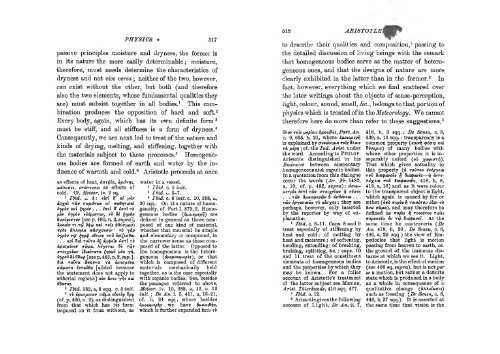ARISTOTLE AND THE EARLIER PERIPATETICS vol.I by Eduard Zeller, B.F.C.Costelloe 1897
MACEDONIA is GREECE and will always be GREECE- (if they are desperate to steal a name, Monkeydonkeys suits them just fine) ΚΑΤΩ ΤΟ ΠΡΟΔΟΤΙΚΟ "ΣΥΝΤΑΓΜΑΤΙΚΟ ΤΟΞΟ"!!! Strabo – “Geography” “There remain of Europe, first, Macedonia and the parts of Thrace that are contiguous to it and extend as far as Byzantium; secondly, Greece; and thirdly, the islands that are close by. Macedonia, of course, is a part of Greece, yet now, since I am following the nature and shape of the places geographically, I have decided to classify it apart from the rest of Greece and to join it with that part of Thrace which borders on it and extends as far as the mouth of the Euxine and the Propontis. Then, a little further on, Strabo mentions Cypsela and the Hebrus River, and also describes a sort of parallelogram in which the whole of Macedonia lies.” (Strab. 7.fragments.9) ΚΚΕ, ΚΝΕ, ΟΝΝΕΔ, ΑΓΟΡΑ,ΕΚΚΛΗΣΙΑ,ΝΕΑ,ΦΩΝΗ,ΦΕΚ,ΝΟΜΟΣ,LIFO,MACEDONIA, ALEXANDER, GREECE,IKEA
MACEDONIA is GREECE and will always be GREECE- (if they are desperate to steal a name, Monkeydonkeys suits them just fine)
ΚΑΤΩ ΤΟ ΠΡΟΔΟΤΙΚΟ "ΣΥΝΤΑΓΜΑΤΙΚΟ ΤΟΞΟ"!!!
Strabo – “Geography”
“There remain of Europe, first, Macedonia and the parts of Thrace that are contiguous to it and extend as far as Byzantium; secondly, Greece; and thirdly, the islands that are close by. Macedonia, of course, is a part of Greece, yet now, since I am following the nature and shape of the places geographically, I have decided to classify it apart from the rest of Greece and to join it with that part of Thrace which borders on it and extends as far as the mouth of the Euxine and the Propontis. Then, a little further on, Strabo mentions Cypsela and the Hebrus River, and also describes a sort of parallelogram in which the whole of Macedonia lies.”
(Strab. 7.fragments.9)
ΚΚΕ, ΚΝΕ, ΟΝΝΕΔ, ΑΓΟΡΑ,ΕΚΚΛΗΣΙΑ,ΝΕΑ,ΦΩΝΗ,ΦΕΚ,ΝΟΜΟΣ,LIFO,MACEDONIA, ALEXANDER, GREECE,IKEA
Create successful ePaper yourself
Turn your PDF publications into a flip-book with our unique Google optimized e-Paper software.
PHYSICS • 517<br />
passive principles moisture and dryness, the former is<br />
in its nature the more easily determinable ; moisture,<br />
therefore, must needs determine the characteristics of<br />
dryness and not vice versa ;<br />
neither of the two, however,<br />
can exist without the other, but both (and therefore<br />
also the two elements, whose fundamental qualities they<br />
are) must subsist together in all bodies. 1 This combination<br />
produces the opposition of hard and soft. 2<br />
Every body, again, which has its own definite form 3<br />
must be stiff, and all stiffness is a form of dryness. 4<br />
Consequently, we are next led to treat of the nature and<br />
kinds of drying, melting, and stiffening, together with<br />
the materials subject to these processes. 5 Homogeneous<br />
bodies are formed of earth<br />
and water <strong>by</strong> the influence<br />
of warmth and cold. 6<br />
Aristotle proceeds at once<br />
as effects of heat, airityia, a>)i6rqs, water in a vessel.<br />
4<br />
ixiiXvais, aT&Ttvais as effects of Ibid. c. 5 init.<br />
cold. Cf. Meteor, iv. 2 sq.<br />
5 Ihid. u. 5-7.<br />
1<br />
Ibid. u. 4 : eio-1 8' al per e Ibid. c. 8 init. c. 10, 388, a,,<br />
dpxpur\x.kvov awna. Aeyfrai Be run posed of the latter. Opposed to<br />
ffToix^W ISiairara |jjpoB fitv 77), the homogeneous is the heteroiypovfihSfiap<br />
[seep. 483, n. 2, swp.~\. geneous (duofioto/xipis), or that<br />
fita ravra airavra to upifffieva which is composed of different<br />
tr&iuvra ivravBa [added because materials mechanically held<br />
the statement does not apply to together, as is the case especially<br />
setherial regions] ovk avev yrjs u.a\ with organic bodies. See, besides<br />
BSotos. the passages referred to above,<br />
2 Ibid. 382, a, 8 sqq. c. 5 init. Meteor, iv. 10, 388, a, 13. c. 12<br />
3<br />
rb &pifffievov irafia oliceicp 8pa init. ; De An. i. 5, 411, a, 16-21,<br />
(cf . p. 480, n. 2), as distinguished cf . b, 24 sqq , where besides<br />
from that which has its form Sfioiofiep^s we have d/wieifiiis,<br />
imposed on it from without, as which is further expanded into -rb<br />
518 ARISTOTLm<br />
to describe their qualities and composition, 1 passing to<br />
the detailed discussion of living beings with the remark<br />
that homogeneous bodies serve as the matter of heterdgeneous<br />
ones, and that the designs of nature are<br />
more<br />
clearly exhibited in the latter than in the former. 2 In<br />
fact, however, everything which we find scattered over<br />
the later writings about the objects of sense-perception,<br />
light, colour, sound, smell, &c, belongs to that portion of<br />
physics which is treated of in the Meteorology. We cannot<br />
therefore here do more than refer to these suggestions, 3<br />
'oKov rots fxopiois 6/ji.oet$es, Part. An.<br />
ii. 9, 655, b, 21, where S/ioiofiepfi<br />
is explained <strong>by</strong> o-vy&vvfia toTs S\ois<br />
Ttfc /i4p7i ; cf . the Ind. Arist. under<br />
the word. According to Philop.<br />
Aristotle distinguished in his<br />
Eudemvs between elementary<br />
homogeneous and organic bodies.<br />
In a quotation from this dialogue<br />
occur the words (Ar. I'r. 1482,<br />
a, 10, cf. p. 482, supra) : do-v/ifierpia<br />
eot! tuv
















